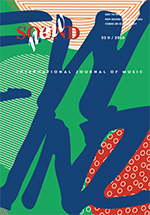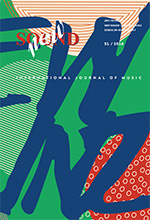Issue No. 27
Composer Speaks
Branka Radović – SEARCHING FOR THE IDENTITY OF THE COMPOSER AND MAN. AN INTERVIEW WITH RASTISLAV KAMBASKOVIĆ
Download: ser / eng
In Memoriam
Roksanda Pejović – COMPOSER DUŠAN KOSTIĆ (23/1/1925–6/10/2005)
Abstract: Dušan Kostić was an original and impulsive character, inclined to irony. His cmpositions remind his colleagues to their own youth of about 1950th when the students of Belgrade Musical Academy left tradition in order to be near modern trends.
Download: ser / eng
Studies
Branka Radović – DEJAN DESPIĆ: PESMARICA (1950–2004)
Abstract: Many compositions by Dejan Despić are related to literature. They are not vocal, but instrumental compositions with main topics being: nature, love, death, homesickness, ephemerality. The wide scope of the used works of writers and poets is mainly from the 20th century, Jovan Dučić takes the major position. The Three Meditations for violoncello and orchestra, inspired by French poetry are characterized by the highest artistic value. A list of 57 of various kinds inspired by literature support the main idea of the paper.
Download: ser / eng
Interpretations
Sonja Marinković – THE JUBILEE OF SHOSTAKOVICH
Abstract: In the year 2006 the world celebrates one hundred years since the birth of Dmitri Shostakovich, the author who’s work provoked very different, even conflicting opinions, so the occasion presents the opportunity for many reevaluations. In this article Sonja Marinković presents the subject of the reception of Shostakovich’s music in the musical writings of Yugoslavia.
Download: ser / eng
Views
Iva Nenić – WORLD MUSIC: FROM TRADITION TO INVENTION
Abstract: The discourse of world music (a global phenomenon understood here as both global musical culture and distinct genre of popular music) is composed of several ideological positions that have fought for the primacy throughout the genre’s history. First ideological stance can be described as the perspective of a Westerner who perceives music of non-Western cultures as an ‘exotic’ and ‘strange’ (albeit attractive) musical Otherness. This initial meaning guided the invention of ‘world music’ marketing label by western record companies during the eighties. Soon the label was taken by the cultures of the Second and Third world, followed by significant alterations of world music’s meaning together with the inclusion of sub-genres such as “ethno-pop”, “new age music” and numerous traditional musics. As an outcome of this process, several definitions and subsequent ideologies of world music appeared, dealing differently with the notions of “tradition”, “authenticity”, “fusion” and “globalization”. At the same time, scholars within ethnomusicology, anthropology and culture studies sought to describe and interpret a variety of identity positions that the broad culture of today’s world music offers. The academic discussion becomes remarkably fierce in case of music of ‘preliterate’ societies such as the Pygmy groups of Africa, where the lack of a native control over meaning and exploitation of music seems particularly evident. Nevertheless, scholarly defense of native music’s culturally specific meanings that deconstructs usual stereotypes and misuses can also slip into a sort of counter-ideology, where even culturally aware treatments of native music are categorized as exploitative and non-sensitive vis-à-vis indigenous values. Steven Feld’s neologism pygmy pop points to (ab)uses of traditional Pygmy music by western musicians and record companies; on the other hand, some ‘pygmy pop’ examples epitomize quite diverse strategies in dealing with the Otherness. In the overall context of world music, those differences embody either modernistic view of ‘other’ music (its import into the Western heritage) or postmodern interpretation (carefully designed strategies of representing the otherness).
Download: ser / eng
New Works
Zorica Premate – MUSIC FOR THE END OF POSTMODERNISM
Abstract: Ko je ubio galeba? (ti, zar se ne sećaš) (Who killed the seagull? /you did, don’t you remember/) is the full title of the composition written for twelve cellos by Zoran Erić. It was premiered by “The 12 Cellists of the Berlin Philharmonic” at their concert at Kolarac Foundation on April 17, 2005, as a commission from the concert organizer, the Foundation’s Centre for Music. This composition can be observed in two essential contexts: in connection between composer’s music for scene and his “free” pieces, as well as in context of political atmosphere and spirit of time in Serbia today.
Download: ser / eng
Tatjana Marković – ON/IN THE ORBITS OF ALEKSANDRA VREBALOV
Abstract: Serbian composer Aleksandra Vrebalov (b. 1970) has been living in New York gained a very successful international career. This paper deals with one of her recent composition, Orbits for symphony orchestra, written in November 2002. It was performed for the first time in Novi Sad in 2005. The work is based on specific “double” structure spiral-like, according to the measures of Fibonacci Sequence. Orbits are also characteristics after its richly colored orchestration.
Download: ser / eng
Bojana Cvejić – THE END OF INTUITION. MARKO NIKODIJEVIĆ: MUSIC BOX/SELBSTPORTRAIT MIT LIGETI UND STRAWINSKY (UND MESSIAEN IST AUCH DABEI)
Abstract: In reviewing the composition music box/selbstportrait mit Ligeti und Strawinski (und Messiaen ist auch dabei) I assume the interpretative standpoint of Luhmann’s theory of social systems. Specifically, I interpret the complexity of the compositional procedure, which applies the computer software of digital analysis, using the model of autopoietic system whose basic characteristics are self-referentiality of system organization, i.e. operation, and openness of structure which emerges from its interaction with the environment, in this case music material. The third argument concerns the “blind spot” or a standpoint which, according to Luhmann, entails “observing” other systems or, more precisely, “observing the observing” of others, in this case Ligeti, Stravinsky and Messiaen, whose music references are a by-product of system operation with the mechanical aspect of their compositional writing. The conclusion confirms bears out the argument that, although my standpoint is contingent, i.e. it could be theoretically different, an interpretation focusing, for example, on the rhetoric of musical affects would have to acknowledge Nikodijević’s constructivist showdown with the legacy of the composer-genius of intuitive creation.
Download: ser / eng
Analysis
Anica Sabo – PROBLEMS CONCERNING THE TERMINOLOGICAL DEFINING OF ELEMENTS OF THE STRUCTURAL LEVEL OF THE MUSIC FLOW: THE MUSIC PHRASE
Abstract: In contemporary works from the field of music form, there is a wide variety of terms defining elements of the structural level. This paper aims to register and critically analyze the terms that are in use.
Download: ser / eng
Research and Tradition
Anne Caufriez – THE PORTUGUESE BALLAD AS AN EMBLEMATIC SONG?
Abstract: This paper retraces the role of the Portuguese ballad in a synchronic and diachronic manner. The ballad, called in Portugal romance could be sung or recited. Through the centuries, romances were at first the genre performed by the jongleurs (14th and 15th centuries) while in the Renaissance (16th century) they became court songs, highly esteemed by the Iberian monarchs and inspired first compositions for vihuela as well as dramatic writers (e.g. Gil Vincente). Later, during Portugal’s conquest of its colonial empire, they served as emblematic songs of the nation. Consequently, they were spread in Madera, Brazil, Goa, São Tomé and the Jews brought them to Mediterranean. 17th century saw the decline of the romances (as well as court repertoire) and, since than, they form a part of the popular tradition. The popular romanciero (corpus of romances) was revived by the great romantic poet Almeida Garrett (19th century) as an inspiration for his own poetry and, at the beginning of the 20th century, by philologist Th. Braga. Under the Salazar’s dictatorship, from the 1970’s, romances inspired urban songwriters and some classical composers. The lieder of this musical movement, based on the popular tradition, was singer José Afonso (died in 1987) who became a symbol of the anti-fascist struggle of the students, syndicates and workers. With him, the ballad left the village and became urban song with guitar or larger instrumental ensemble accompaniment.
Download: ser / eng
Students' Papers
Ivana Vesić – THE LISTENER AND “SPACE FOR WORK” IN ANTON VON WEBERN’S DODECAPHONIC MUSIC
Download: ser / eng
Festivals and Symposia
Ivana Stefanović – MUSIC FESTIVALS IN TURKEY
Download: ser / eng
Ivana Stamatović – THE 14TH INTERNATIONAL REVIEW OF COMPOSERS. Belgrade, October 27–31, 2005
Download: ser / eng
Mirjana Veselinović-Hofman – “UNYAZI”: ELECTRONIC MUSIC SYMPOSIUM + FESTIVAL 2005. Johannesbourg, University of Witwatersand: Wits School of Arts, 1–4 September
Download: ser / eng
Reviews
Ivana Neimarević – IVANA MEDIĆ: KLAVIRSKA MUZIKA VASILIJA MOKRANJCA (THE PIANO MUSIC OF VASILIJE MOKRANJAC). Ivana Medić, SKC 2004
Download: ser / eng
CD Reviews
Vesna Mikić – MILAN MIHAJLOVIĆ: MEMENTO. PGP-RTS, CD 431 425 SOKOJ (2005)
Download: ser / eng
Melita Milin – VLADAN RADOVANOVIĆ: MUZIKA SFERA (MUSIC OF THE SPHERES). Double compact disc, PGP RTS, no. 431753, Belgrade, 2005
Download: ser / eng
Selena Rakočević – MUSIC FROM MONTENEGRO. Concerts Sweden, Caprice Records & Swedish International Development Authority. Stockholm, Sweden 2005
Download:ser / eng
Defended Theses
Bojana Cvejić – CONCEPT, THEORY AND IDEOLOGY OF PERFORMANCE AND PERFORMATIVITY IN XX CENTURY MUSIC. BEYOND MUSICAL WORK: THE PERFORMATIVE PRACTICE OF MUSIC OF ERIK SATIE, FLUXUS, JOHN CAGE, LA MONTE YOUNG AND JOHN ZORN
Download: ser / eng
Ivana Medić – THE THEORY AND PRACTICE OF THE TOTAL WORK OF ART (GESAMTKUNSTWERK) IN THE 20TH CENTURY
Download: ser / eng
New Sound CD No. 27
1. Rastislav Kambasković: Kumb, for brass instruments
2. Dušan Kostić: Piano Sonata
3. Dejan Despić: Poem Op.89 No.1, for soprano, clarinet and piano
4. Zoran Erić: „Who shot a seagull? (Don’t you remember, you shot a seagull)“ A. Chekhov, for twelve cellos
5. Aleksandra Vrebalov: Orbits, for symphony orchestra


